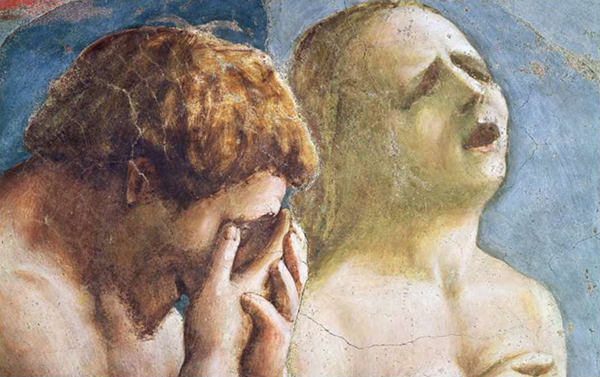Class News
Stephen Greenblatt '64 on Adam and Eve
Here is a review of Stephen Greenblatt's book The Rise and Fall of Adam and Eve, published by Norton in 2017. The review was published in The Wall Street Journal on September 8, 2017.
When Our Eyes Were Opened
Why a primitive tale of sex, death, taboo, temptation — and snakes — still fascinates and confounds

At the end of his panoramic survey of the effects on humanity of the story of Adam and Eve — from the earliest Sumerian folk tales to the theological interpretations of Rabbinic scholars, from St. Augustine to Islam, from the poetic reconstructions of Milton to the magnificent depictions in Renaissance sculpture and painting — Stephen Greenblatt arrives in Kibale National Park, Uganda. His back aches, ants scurry at his feet, and beautiful butterflies float around his head as he makes his way to the Kibale Chimpanzee Project.

Seeing these creatures, in what he calls their edenic state, Mr. Greenblatt says that “they enable us to see for ourselves what the Genesis origin story might have actually looked like, had it been real. Closely resembling us, they show us what it is to live without the knowledge of good and evil. . . . They are still in Paradise.” Eventually the author meets two: the 22-year-old alpha male Eslom and his Mrs. Robinson-style partner, Bubbles, an ape in her mid-50s with a spectacularly swollen rump that reveals she is still game for action. In another part of the clearing, we encounter 19-year-old Leona, a more sheepish female who uses this moment to escape the domineering attentions of Eslom and elope with the younger beta male Lanjo. We knew from the beginning how a book about Adam and Eve simply had to end, but there is something delicious about Mr. Greenblatt’s application of the great Miltonic words to Leona and Lanjo: “The world was all before them.”
Like the original Sumerian tale, refashioned by the Hebraic fashioners of Scripture, Mr. Greenblatt’s superb joke ripples with ambiguities. In Christian readings of the story, the snake persuades the woman that God was lying, that the Almighty would not kill her and her man simply for eating the forbidden fruit. Genesis 3:4-5 has the snake telling her: “You will not die. For God knows when you eat of it your eyes will be opened.” This declaration is far from suggesting, as Mr. Greenblatt might have it, that Adam and Eve were immortal before the fall, or that death itself was one consequence of eating the fruit. Surely it is the snake, in the Bible, who offers the temptation of immortality, not Yahweh? The snake, being a liar, says the opposite of what is true.
In many Genesis passages, the final editor or redactor has collated at least two narratives. Are we to envisage two trees, for instance, or just one? As the narrative stands, there is the Tree of Life and the Tree of the Knowledge of Good and Evil. The tree from which God does not want Adam and Eve to eat will give the man and the woman moral knowledge. It is less clear what the Tree of Life is. Only after they have eaten from the former tree (Genesis 3:6) does the text suggest that eating the fruit of the latter would have given immortality.
Mr. Greenblatt speaks at one point of the serpent who “robs the man and the woman of their hope of eternal life” in the Genesis version. But this can’t be right. For a start, the Adam and Eve myth in Genesis has its origins during the time when the Hebrews were in Babylonian exile. Even if you think that it was edited and written down much, much later, consider that the first shimmering of Jewish belief in life after death arose only in the Hebrew wisdom literature — for instance, in Proverbs, Ecclesiastes, and the Song of Solomon — a hundred years or so before Christ. Before that (witness the many psalms to this effect) death is seen as the end in the Bible.
The original story was not about Adam and Eve losing immortality. It could have been, however, even in its Sumerian origin, about the human capacity to kid ourselves that we are not going to die — that is something very different. In other words, this story’s abiding appeal is bound up with the extreme theological ambiguities it explores.
Mr. Greenblatt asks, at the beginning of his quest: “What kind of God would forbid his creatures to know the difference between good and evil?” Good question, and the one with which the Bible bravely kicks off. The answer must be, “a very sensible God,” if by God you mean an absolutist cosmic dictator. For, as the snake realized in the story, the minute you developed a moral sense, you would wonder why you need to be “told” what to do by a “God.” Far from worshiping God as the upholder of the moral order, as the Jews do — the very name for the first five books of the Bible is the Torah, or Law — you would begin to feel morally self-sufficient. You would be like, say, Euripides, whose tragedies question, again and again, the bullying decrees and tricks of the immortals who cause disaster and sorrow to befall us. You would come to sympathize with Antigone or Hecuba or Hippolytus, who try to fashion dignified moral responses to the pickle in which the immortals place them.
The Bible occasionally plays out such dramas, most notably in Job but also in some of the stories about Abraham — for example, the deliberately semi-comic tale in which he pleads with Yahweh not to eliminate all the inhabitants of Sodom if he can find 50 honest men among them, and then 45, and 40, and so on. More usually, however, the Jewish tradition speaks of humanity as creatures whose torment and glory are a sense of good and evil. We are not playthings of the gods; we are the children of Adam and Eve.
Neither the Hebrew version nor the Sumerian original seem to have carried any suggestion that there would some day come a second Adam who would restore immortality to the human race, and Mr. Greenblatt confines to an endnote St. Paul’s idea of Christ as the second Adam. He devotes more space to the reinterpretation of Pauline theology by Augustine, who in his portrayal originally saw the story as an embarrassingly primitive fable but in time made it central to his sophisticated conception of original sin and ultimate redemption.
Mr. Greenblatt, a professor of the humanities at Harvard University, is especially eloquent on the influence of this story on the early modern imagination. In the future, I know I shall return often to his reflections on the Renaissance painters — Masaccio, Michelangelo, Dürer — and to his masterly exposition of “Paradise Lost,” “the greatest poem in the English language.” Parts of three chapters are devoted to Milton (40 times more space than is devoted to St. Paul!) but that is only proper. What Mr. Greenblatt is writing about here, most of all, is the redeeming and enlightening power of story. “More than a thousand years after Augustine, Adam and Eve have finally become real” in Milton’s poem.
There are unexpected consequences to this emphasis on the “realism” of Milton. Mr. Greenblatt writes, in several places, as if all the early commentators on the Adam and Eve story — including Augustine, Origen, the Gnostics, and others — believed in what we should call the historicity of the story. Indeed, he begins his survey by stating that “an insistence on the story’s literal truth — an actual Adam and Eve in an actual garden — became one of the cornerstones of Christian orthodoxy.” Very many, perhaps a majority, would nowadays agree with Mr. Greenblatt, but I am not convinced.
How can we be sure that our post-Enlightenment distinction between “literal truth” and symbolism would have been part of, say, Milton’s or Michelangelo’s or even St. Paul’s mental furniture? Dante is often mentioned in this book, but I do not believe that he was writing his journey through hell, purgatory, and heaven as a travelogue or that he believed in the “literal” existence of these places in the same way that he believed in the existence of Florence. The concept that Adam and Eve were “historical” characters came about through primitive scientific 17th-century attempts to “date” the Bible, and this led to much muddled thinking.
Darwin, who occupies our attention in the penultimate chapter of Mr. Greenblatt’s story, really did believe, as a young man, in the literal truth of “Paradise Lost,” which was also his favorite reading during his voyage on the Beagle. When he lost this belief, he thought he had lost belief in Christianity. This led, perhaps, to some of his confusion of mind when he came to distinguish between what Christianity does and does not claim about creation.
In common with most Victorian scientists, Darwin had no understanding of the multiple authorship of Genesis. He read the two creation stories as suggestive that species were created as finished products from the hand of God. He therefore thought, as most of his contemporaries did, that to believe in the mutability of species was to challenge the Bible narrative. But Genesis 1:30, in which God says he has given the breath of life to every living creature, surely allows of the possibility of development or mutation. Darwin on the Beagle read and re-read Milton, and it is “Paradise Lost,” not the Bible, that gives us the unambiguous story of immutable species created by God.
Mr. Greenblatt quotes one paragraph, a notorious one, from Darwin’s The Descent of Man in which Darwin says that he would prefer to have been descended from a baboon than from a “savage.” Indeed, what made Alfred Russel Wallace part company from his old comrade in natural selection was Darwin’s suggestion in The Descent of Man that our capacity (as humans) for reason, language, and moral judgment is different in degree, not in kind, from that of our cousins, the other animals. Mr. Greenblatt is too kind to quote any of Darwin’s laughable attempts to explain the evolution of language, including his false claim that the peoples of Tierra del Fuego communicated in a few grunts and had almost no vocabulary. (Later visitors, compiling a dictionary of their language, found a vocabulary of more than 30,000 words.)
The richness of the Adam and Eve story is, in our own day, set against the story created by Darwin of the evolved ape. Both are powerful images in our brains, and most educated people believe, or try to believe, in the latter. What Mr. Greenblatt’s wonderfully rich, detailed, humorous, and imaginative survey reveals is the sheer wealth of the biblical mythology and how it continues to raise questions that Darwinism doesn’t answer.
The subtlety of the Bible account lives even in the thought of those, like Darwin or Nietzsche, who would most like to escape it. We feel ourselves strangers in the world, exiles from paradise, morally angst-ridden, not only about the human capacity for sin but also about the injustice that appears to be rained upon the innocent by indifferent nature or a cruel divinity. All of these feelings and ideas, with all their contradictions, are contained in the enduringly disconcerting story of Adam and Eve.

